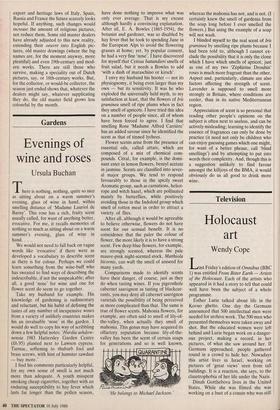Gardens
Evenings of wine and roses
Ursula Buchan
There is nothing, nothing, quite so nice as sitting about on a warm summer's evening, glass of wine in hand, within smelling distance of 'Madame Lauriol de Barny'. This rose has a rich, fruity scent usually called, for want of anything better, evocative. For me, it recalls memories of nothing so much as sitting about on a warm summer's evening, glass of wine in hand. . . .
We would not need to fall back on vague words like 'evocative' if there were as developed a vocabulary to describe scent as there is for colour. Perhaps we could learn something from the wine-buff who has sweated to find ways of describing the indescribable, if not the unspeakable; after all, a good 'nose' for wine and one for flower scent do seem to go together.
Take my husband for example. His knowledge of gardening is rudimentary and reluctant, but his habit of defining the tastes of any number of inexpensive wines from a variety of unlikely countries makes his an invaluable 'nose' in the garden. I would do well to copy his way of scribbling down a few helpful notes: 'Hurdia ashdow- nensia 1983 Hattersley Garden Centre (£6.95) planted next to Lawson cypress. Tarmac, softening to rhubarb fool and brass screws, with hint of hamster sawdust — buy more.'
I find his comments particularly helpful, for my own sense of smell is not much more than adequate. A youth misspent smoking cheap cigarettes, together with an enduring susceptibility to hay fever which lasts far longer than the pollen season, have done nothing to improve what was only ever average. That is my excuse although hardly a convincing explanation. After all, E. A. Bowles (1865-1954), the botanist and gardener, was so disabled by hay fever that he took to spending June in the European Alps to avoid the flowering -grasses at home; yet, by popular consent, he had a very fine 'nose'. I have discovered for myself that Cytisus battandieri smells of fruit salad, but it needs a Bowles to add `with a dash of maraschino or kirsch'.
I envy my husband his hooter — not its physiognomy, it being even larger than my own — but its sensitivity. It was he who exploded the universally held myth, to my satisfaction at least, that the flowers of Iris graminea smell of ripe plums when in fact they smell of apricots. I have tried this idea on a number of people since, all of whom have been forced to agree. I find that smelling Rose 'Madame Alfred Carriere' has an added savour since he identified the scent as that of tinned lychees.
Flower scents arise from the presence of essential oils, called attars, which are composed of a mix of chemical com- pounds. Citral, for example, is the domi- nant ester in lemon flowers, benzyl acetate in jasmine. Scents are classified into sever- al major groups. We tend to respond favourably to those in the spicily sweet Aromatic group, such as carnations, heliot- rope and witch hazel, which are pollinated mainly by butterflies, while positively avoiding those in the Indoloid group which smell of rotten meat in order to attract a variety of flies.
After all, although it would be agreeable to believe otherwise, flowers do not have scent for our sensual benefit. It is no coincidence that the paler the colour of flower, the more likely it is to have a strong scent. Few deep blue flowers, for example, are strongly scented, whereas the pale mauve-pink night-scented stock, Matthiola bicornis, can waft the smell of aniseed for many yards.
Comparisons made to identify scents have their danger, of course, just as they do when tasting wines. If you pigeonhole cabernet sauvignon as tasting of blackcur- rants, you may deny all cabernet sauvignon varietals the possibility of being perceived as more complicated than that. The same is true of flower scents. Mahonia flowers, for example, are often said to smell of lily-of- the-valley, when actually they smell of mahonia. This genus may have acquired its olfactory reputation because lily-of-the- valley has been the scent of certain soaps for generations and so is well known, `He belongs to Michael Jackson.' whereas the mahonia has not, and is not. (I certainly knew the smell of gardenia from the soap long before I ever smelled the flowers.) But using the example of a soap will not wash.
I blinded myself to the real scent of Iris graminea by smelling ripe plums because I had been told to, although I cannot ex- clude the possibility that it is only the clone which I have which smells of apricot, just as one of my two `Zephirine Drouhin' roses is much more fragrant than the other. Aspect and, particularly, climate are also factors affecting the strength of scent. Lavender is supposed to smell more strongly in Britain, where conditions are cooler, than in its native Mediterranean region.
Appreciation of scent is so personal that reading other people's opinions on the subject is often next to useless, and can be actively misleading; learning to identify the essence of fragrances can only be done by practice (it need not only be children who can enjoy guessing games which one might, for want of a better phrase, call 'blind smellings') and by attempting to put into words their complexity. And, though this is a suggestion unlikely to find favour amongst the killjoys of the BMA, it would obviously do us all good to drink more wine.


















































 Previous page
Previous page